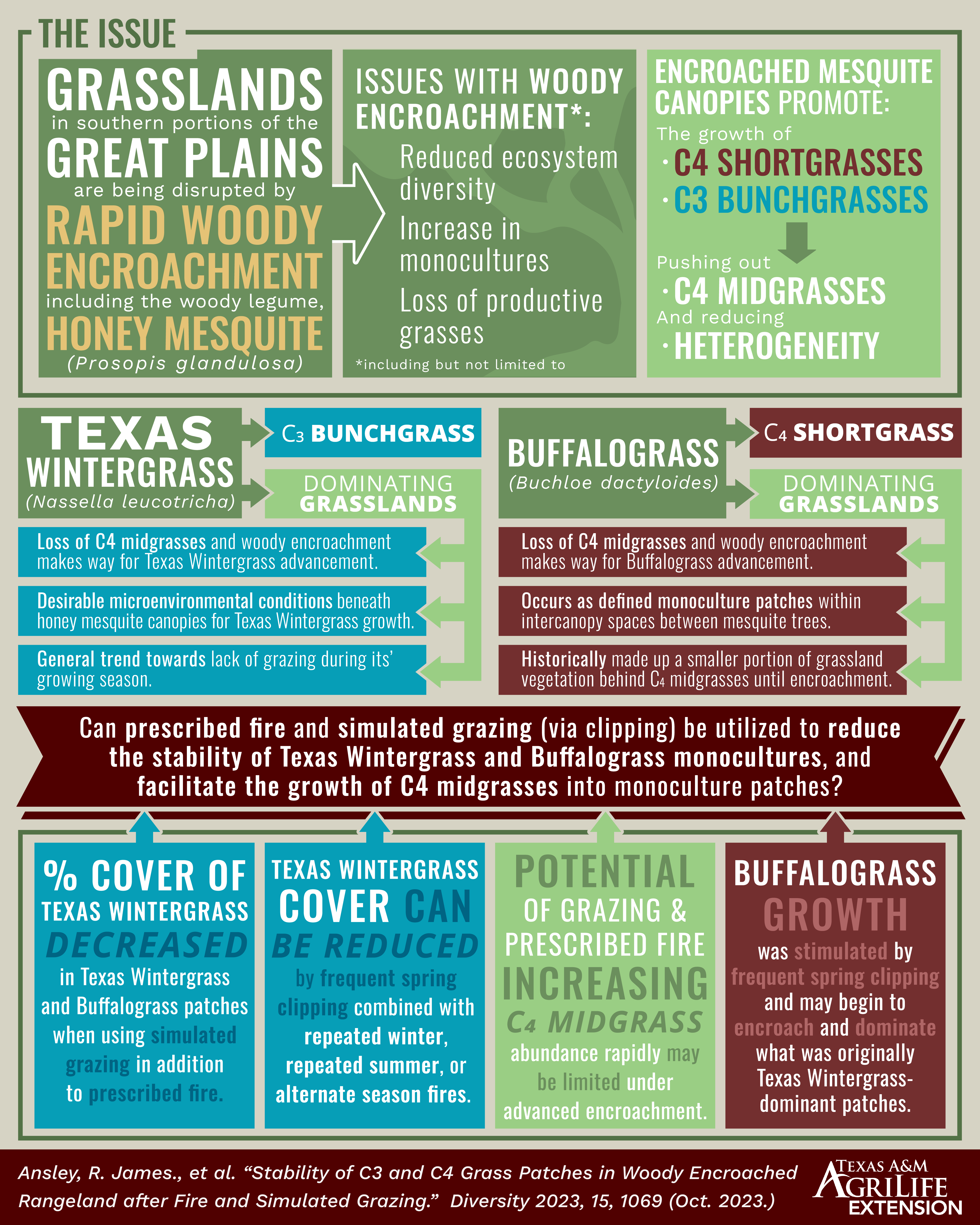 In the western portion of the southern Great Plains, grasslands are defined as “southern mixed”, with warm season or C4 mid-grasses being dominant and cool season or C3 short-grasses in less frequent densities. As woody plant encroachment increasingly dominates, the productive warm season C4 grasses begin to decline with less abundance on the landscape and even less productivity. Woody plant dominance also reduces plant diversity eroding heterogeneity in the mixed-grass prairie. Recently, researchers measured the effects of various combinations of spring clipping (mimicked cattle grazing) and prescribed fire treatments over an 8 year period on Texas wintergrass and buffalograss with the overall objective of reducing Texas wintergrass abundance and increasing warm season C4 mid-grass species and diversity.
In the western portion of the southern Great Plains, grasslands are defined as “southern mixed”, with warm season or C4 mid-grasses being dominant and cool season or C3 short-grasses in less frequent densities. As woody plant encroachment increasingly dominates, the productive warm season C4 grasses begin to decline with less abundance on the landscape and even less productivity. Woody plant dominance also reduces plant diversity eroding heterogeneity in the mixed-grass prairie. Recently, researchers measured the effects of various combinations of spring clipping (mimicked cattle grazing) and prescribed fire treatments over an 8 year period on Texas wintergrass and buffalograss with the overall objective of reducing Texas wintergrass abundance and increasing warm season C4 mid-grass species and diversity.
This study took place in North Central, Texas, and no fires (wildfire or prescribed) had occurred on the study site for at least the previous 40-years. The study had three plots in each of the six treatments. The six treatments included: 1. no fire 2. repeated winter fires (2-yr fire return interval) 3. alternate season fires (winter and summer at 2-yr fire return interval) 4. alternate season fires (winter and summer) 5. two summer fires (2-yr fire return interval) 6. two summer fires (1-yr fire return interval).
For the grazing aspect of this study, within each fire plot, two to three patches were identified. These patches were clipped originally to a 2-cm height twice a year. After the first year, the study shifted to only clipping once a year following peak productivity.
Frequent clipping reduced Texas wintergrass cover across all fire treatments. Buffalograss encroachment into Texas wintergrass patches was greatest in the Clip + Alternate Season fire treatment (winter and summer). C4 mid-grass cover increased to 15–25% in Texas wintergrass patches in several fire-only or Clip + Fire treatments. However, greatest gains of warm season grasses were observed in treatments that included summer fire. These results suggest that C4 mid-grass restoration was linked with treatments that reduced Texas wintergrass cover.
This study demonstrated that Texas wintergrass cover can be reduced, but not eliminated, by frequent spring clipping (as simulated grazing) combined with repeated winter, repeated summer, or alternate season fire treatments. Researchers also interestingly found that buffalograss can encroach and become the dominant grass in what were initially
Texas wintergrass-dominated patches under certain combinations of frequent clipping and seasonal fires. Specifically, buffalograss encroachment into Texas wintergrass patches was greatest in the frequently clipped + alternate season fire treatment. The researchers found little evidence of Texas wintergrass advancement into buffalograss patches under frequent clipping and fire. However, in the absence of clipping, some fire treatments coupled with honey mesquite post-fire regrowth, stimulated Texas wintergrass encroachment into buffalograss-dominant patches.
For more information and the full study, be sure to check out the publication below!
Stability of C3 and C4 Grass Patches in Woody Encroached Rangeland after Fire and Simulated Grazing. Available from: https://www.researchgate.net/publication/374549350_Stability_of_C3_and_C4_Grass_Patches_in_Woody_Encroached_Rangeland_after_Fire_and_Simulated_Grazing [accessed Aug 27 2024].